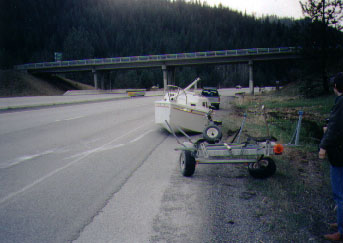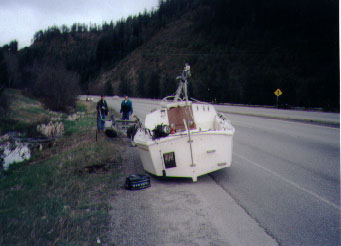| SJ23 Tech Tip A02, (Issued 1997-01-22) Bob Schimmel | |
|
SJ23 Trailer Coupler Considerations - How to Keep the Trailer Attached. |
|
In 1989 a local sailor from the Edmonton area was towing his
Catalina 25 down the highway when the coupler broke off due to a faulty
weld. The trailer tongue immediately dropped to the pavement, the
breakaway chains snapped and
the loose trailer was heading for the ditch.
The sparks from the steel tongue, grinding its way along the
asphalt, were awesome.
They were so bright that he couldn't see the boat. Fortunately, the boat stayed on the bunk boards because it was well
strapped to the trailer and the slope of the ditch was ever so gentle. The
sailor was
extremely lucky that the boat and trailer suffered minimal damage.
 Unfortunately, the
breakaway chains were not crossed under the coupler, rendering them
ineffective to support the trailer tongue. If they were crossed, the damage might have been less, for the trailer would have
hung in the cradle. (It is mandatory to cross your chains in most
US states and all of Canada). I have seen State Patrol officers
and the RCMP glance at a trailer's chains while passing, so beware.
By the way, don't hang the chains bar tight. Leave
a bit of slack so the trailer can turn behind the vehicle. Unfortunately, the
breakaway chains were not crossed under the coupler, rendering them
ineffective to support the trailer tongue. If they were crossed, the damage might have been less, for the trailer would have
hung in the cradle. (It is mandatory to cross your chains in most
US states and all of Canada). I have seen State Patrol officers
and the RCMP glance at a trailer's chains while passing, so beware.
By the way, don't hang the chains bar tight. Leave
a bit of slack so the trailer can turn behind the vehicle.
This incident prompted me to inspect the welds on my factory manufactured trailer of a previous 22' boat. Upon close examination, I found five welds with small cracks. The trailer was 15 years old at the time, with only 3000 miles on it. I repaired the welds and strengthened each joint with a 1/4" thick steel gusset plate. About ten other sailors found similar cracks in their trailers as well. NOTE: It is recommended to bolt and weld the coupler to the trailer frame for maximum strength and security. The reason for this is that sometimes a nice looking weld is just that, a nice looking weld without strength! PS: Because of this narrow escape, most of us in the Edmonton area now inspect our trailers annually, cross our chains and use a couple of heavy duty 10T cargo straps to secure the boat to the trailer. Unfortunately, there are still people who have to learn by their own experience! And just in case you need another reminder to check your trailer thoroughly, the following mishap occurred in the spring of 1998 along I-90 at the Idaho/Montana border. It should be noted that there was no known problem with the trailer prior to this accident.
As
Eric (the new owner) said, "the boat is a
19ft. West Wright Potter. She towed well at 45 mph behind our
blazer. Much
over that and there was a tendency for the trailer to fish-tail. On the bumpy roads, 20
miles east of Cour d'Alene, the right axle gave way just inside the frame. The trailer started to fishtail madly
as I slowed and eased over to the shoulder. Unfortunately,
the boat slid off the trailer, landing on her dagger board, and came to
rest beside the truck, facing the wrong way on a blind curve of I-90.
The curve is a
posted 75 mph zone! The absolute MIRACLE of this mishap is that the boat
is almost unscathed due to the blessing that she landed on her keel.
If
she had rolled, or if there was a semi or someone close to us, things
would have turned out much differently. Sure there is some
scuffed/scratched gel coat and one small hole that will need repair.
Sure
the trailer is beyond hope due to the fact that both leaf springs were
ripped off the frame, but THE BOAT IS OK, I AM OK, AND THE BLAZER IS
OK!!!" |
|
|
Return to Tech Tip Index. . . . . . . . . . . . . . . Have a Question? |

